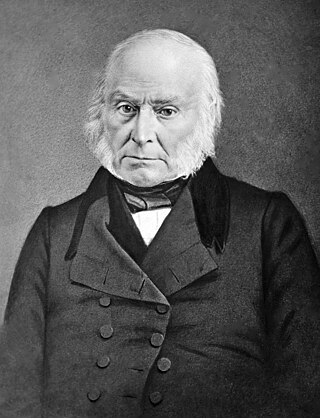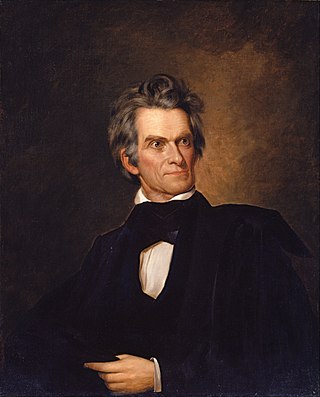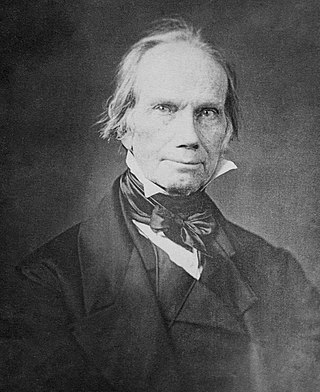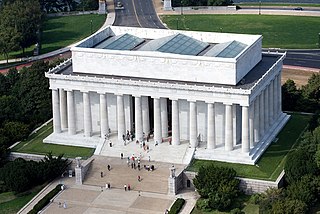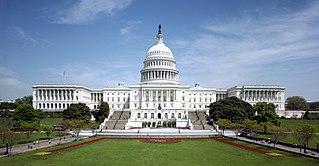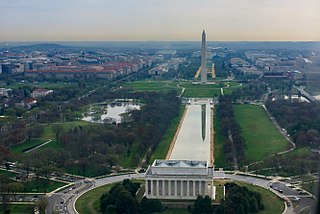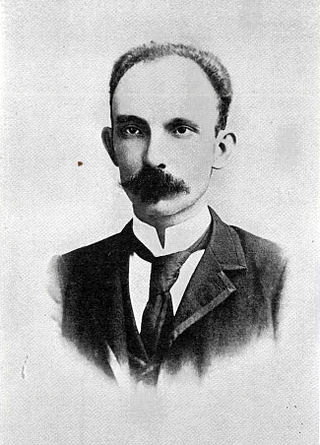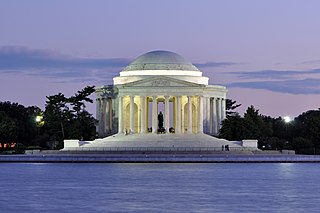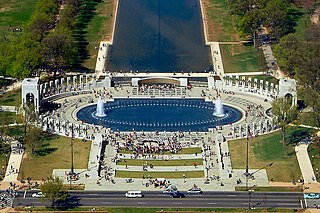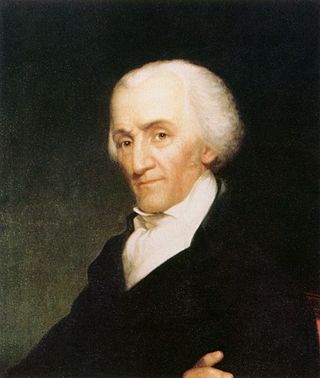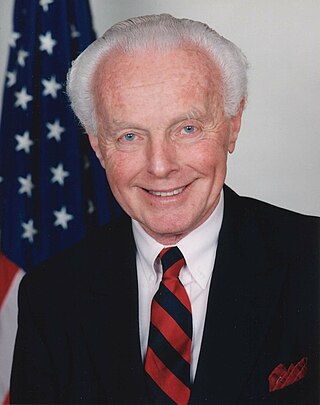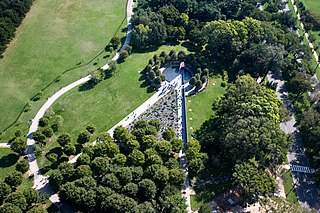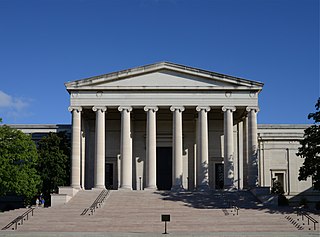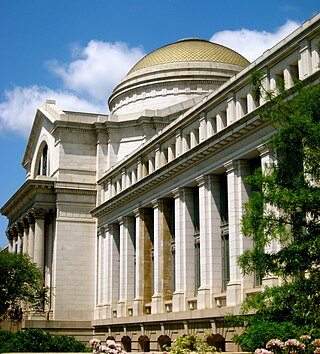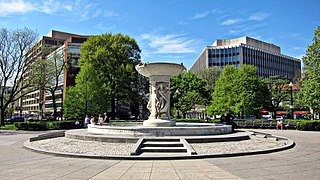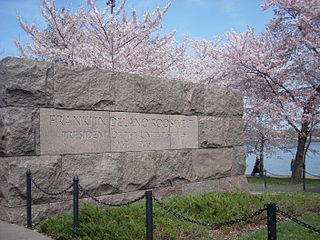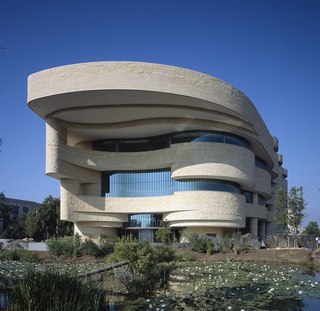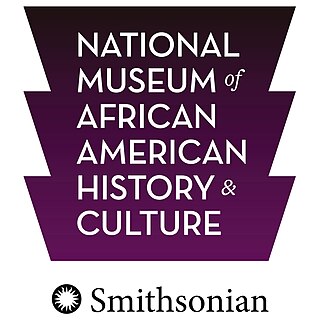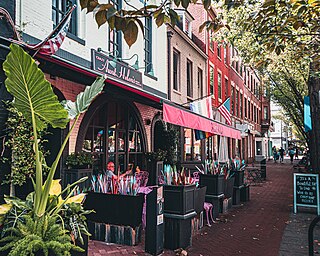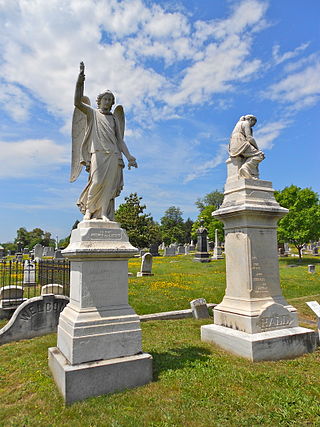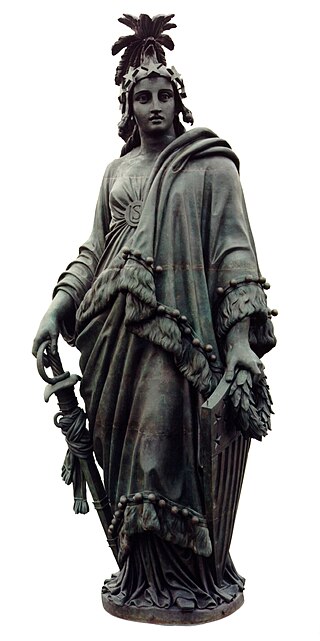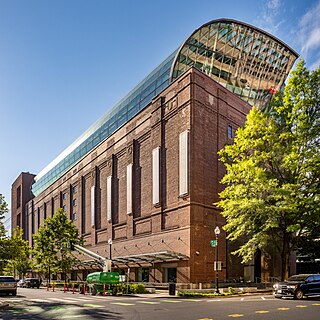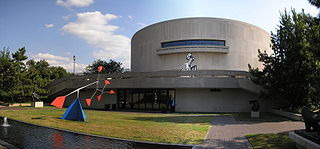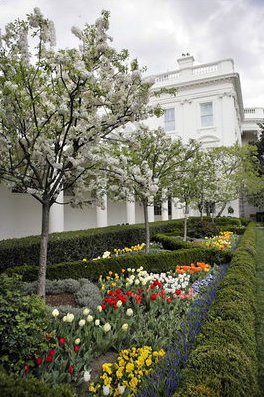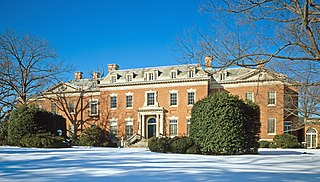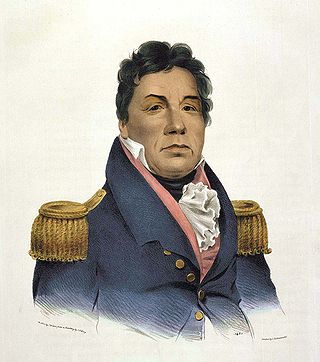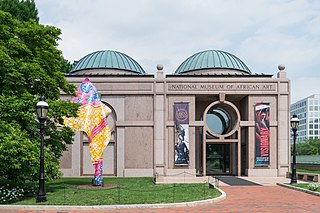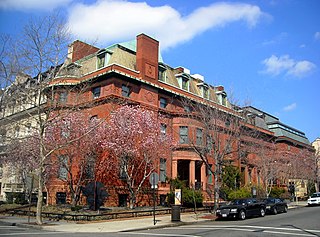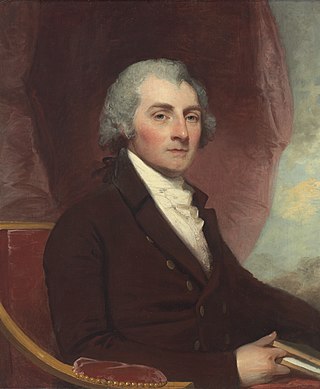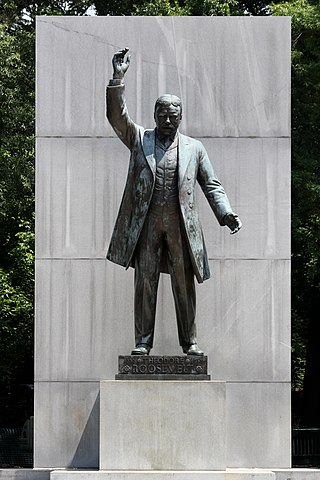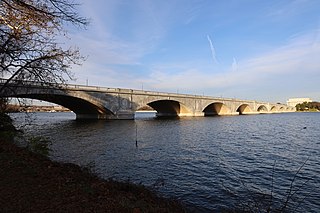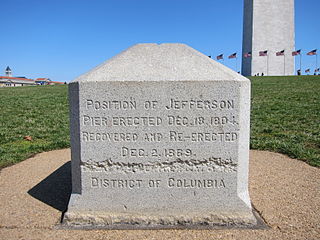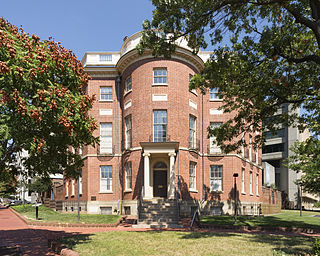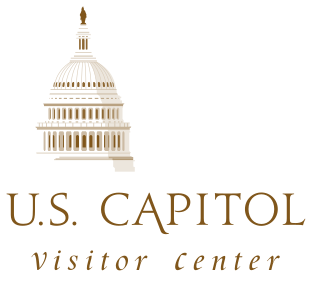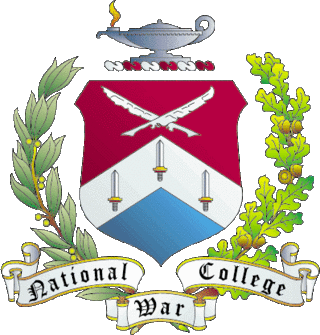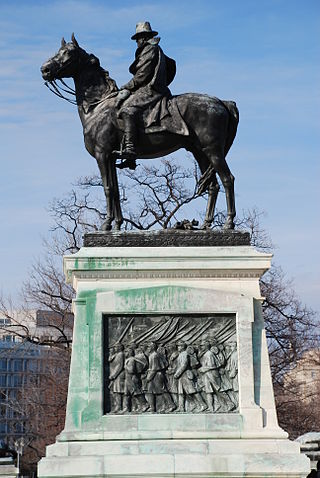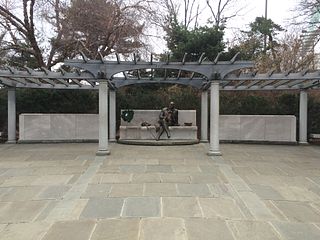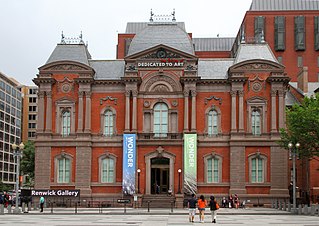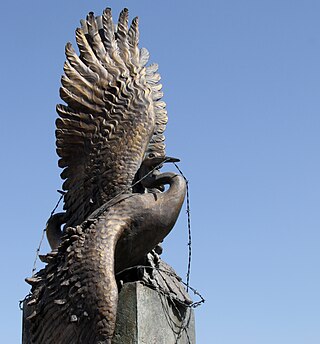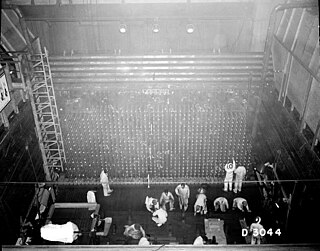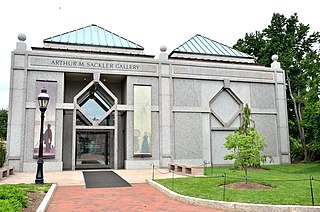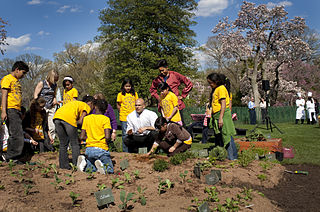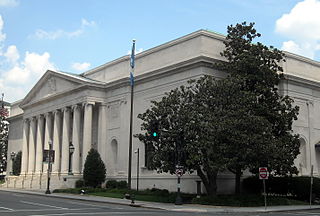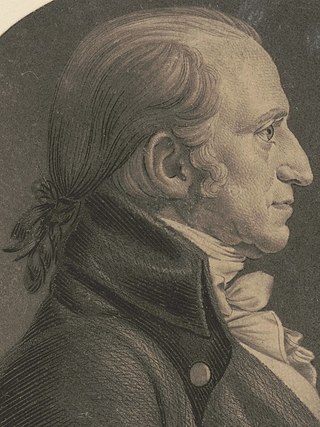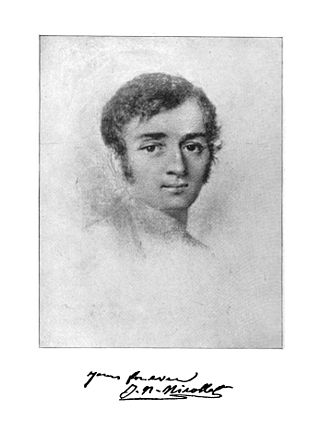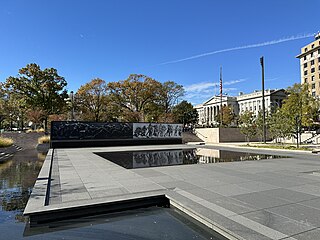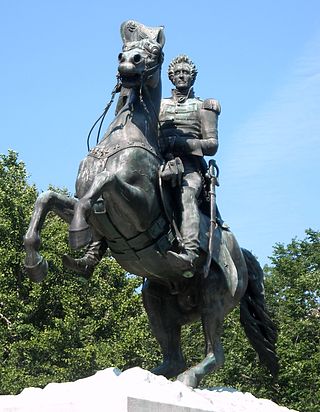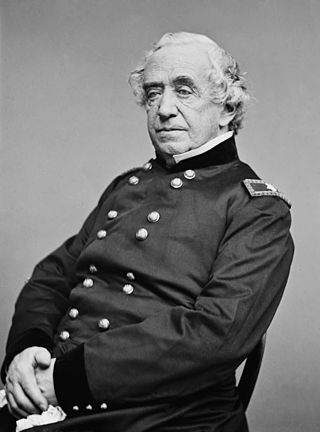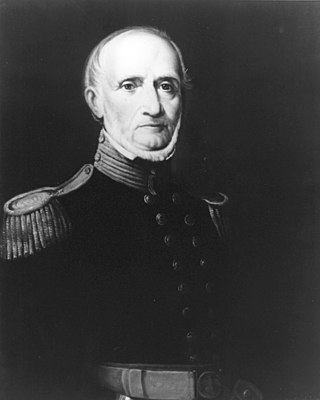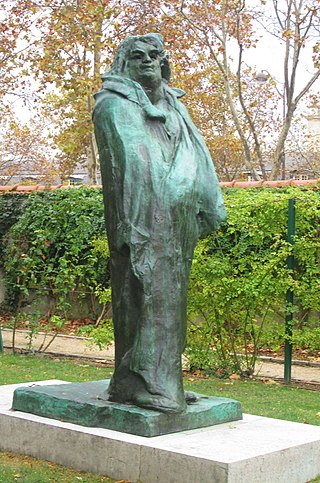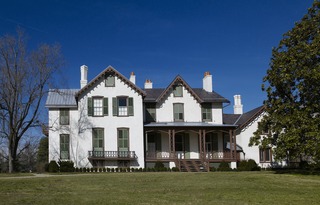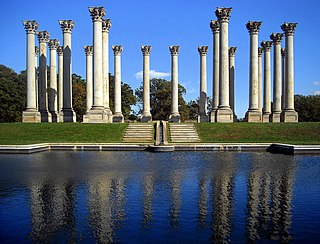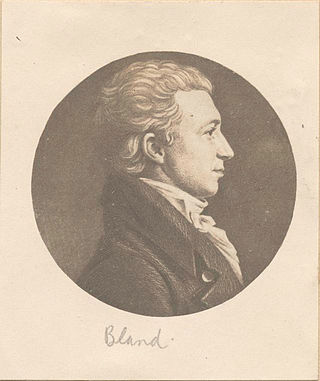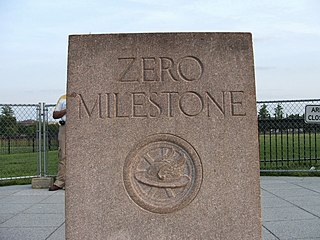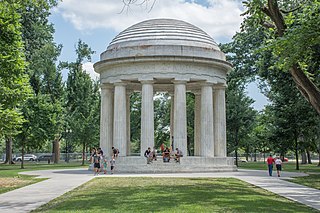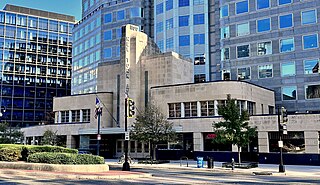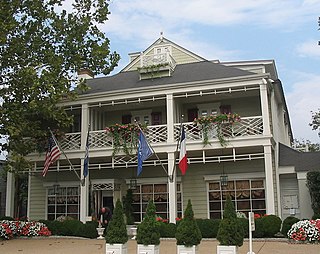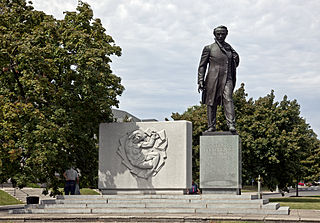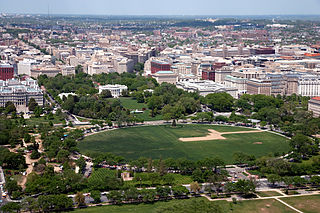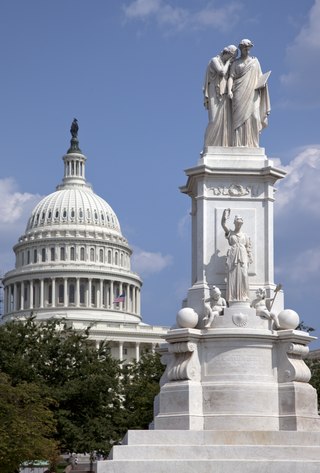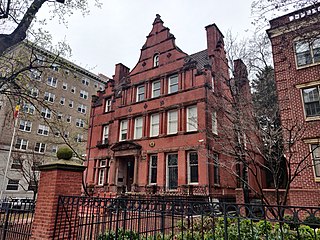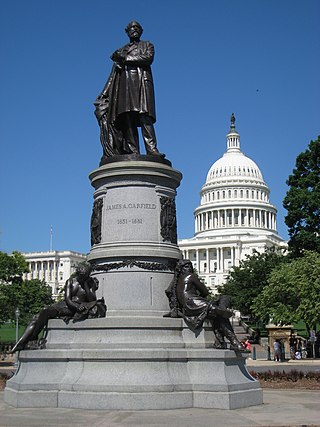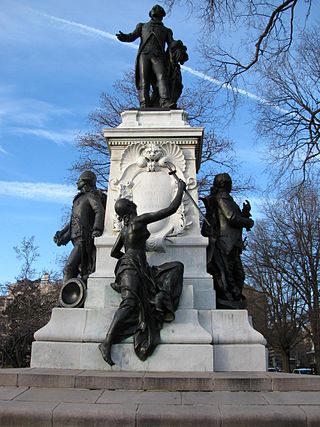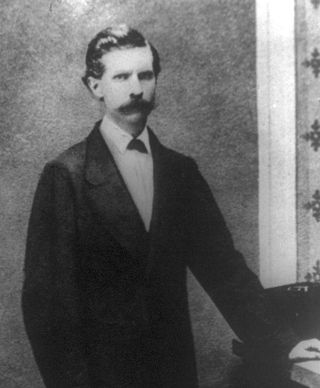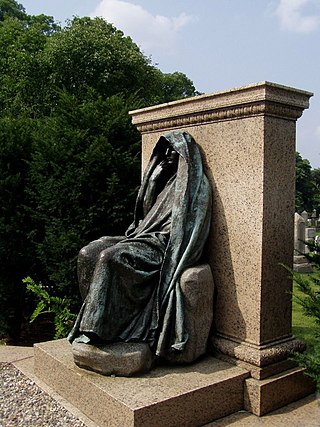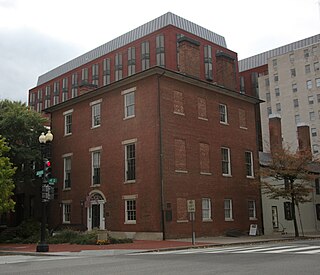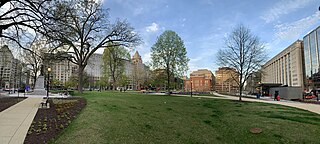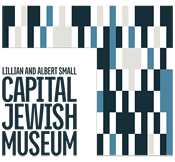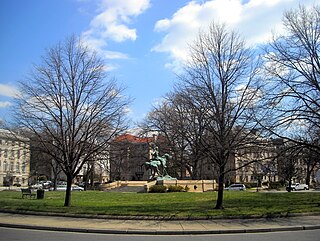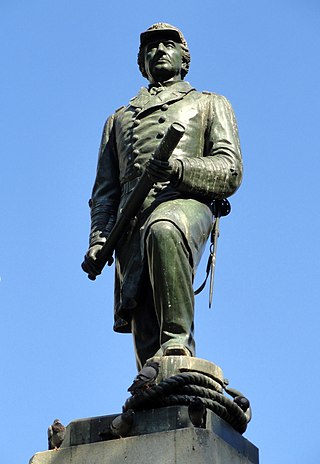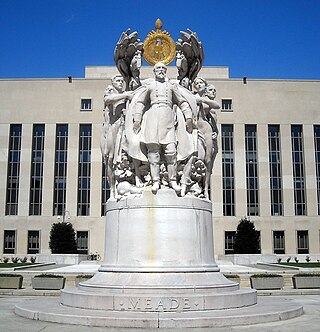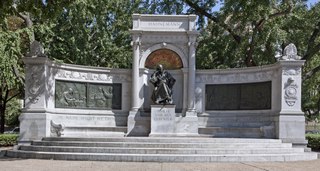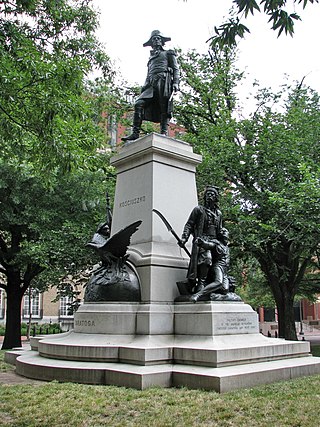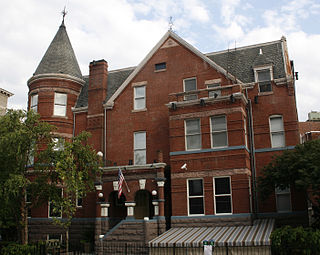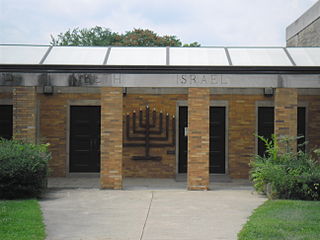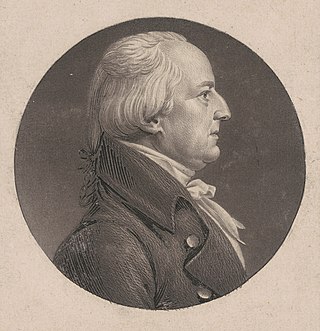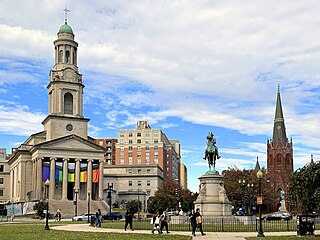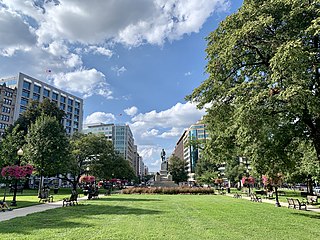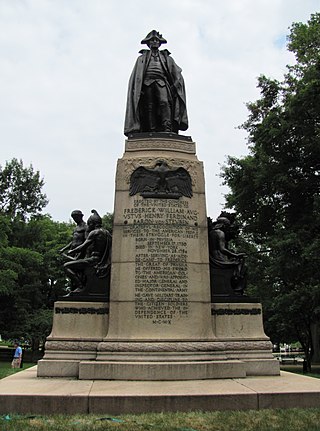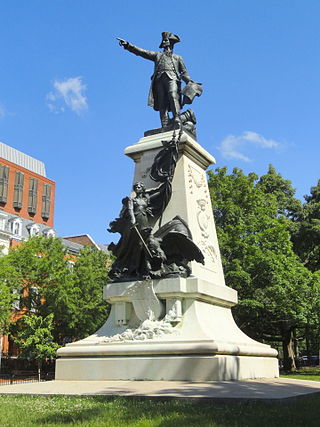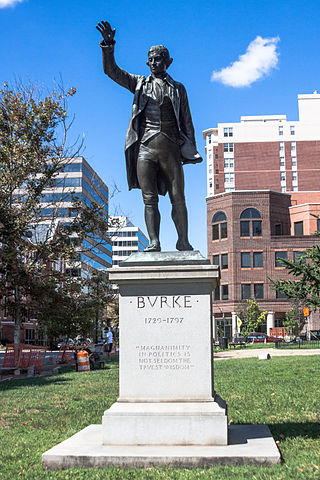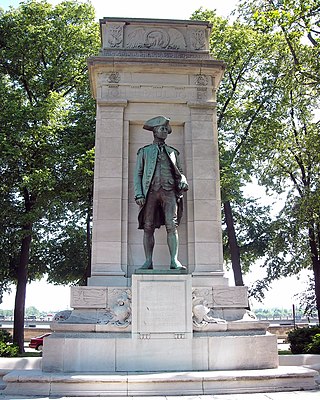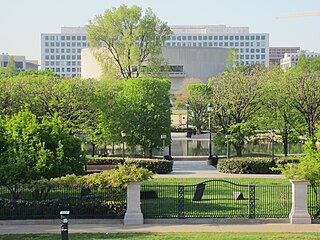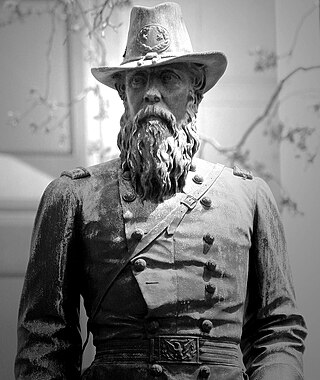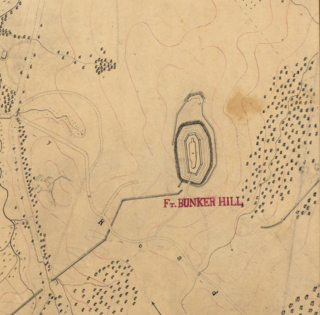100 Sights in Washington, United States (with Map and Images)
Legend
Welcome to your journey through the most beautiful sights in Washington, United States! Whether you want to discover the city's historical treasures or experience its modern highlights, you'll find everything your heart desires here. Be inspired by our selection and plan your unforgettable adventure in Washington. Dive into the diversity of this fascinating city and discover everything it has to offer.
Sightseeing Tours in Washington1. John Quincy Adams
John Quincy Adams was the sixth president of the United States, serving from 1825 to 1829. He previously served as the eighth United States secretary of state from 1817 to 1825. During his long diplomatic and political career, Adams served as an ambassador and also as a member of the United States Congress representing Massachusetts in both chambers. He was the eldest son of John Adams, who served as the second president of the United States from 1797 to 1801, and First Lady Abigail Adams. Initially a Federalist like his father, he won election to the presidency as a member of the Democratic-Republican Party, and later, in the mid-1830s, became affiliated with the Whig Party.
2. John C. Calhoun
John Caldwell Calhoun was an American statesman and political theorist who served as the seventh vice president of the United States from 1825 to 1832. Born in South Carolina, he adamantly defended American slavery and sought to protect the interests of white Southerners. Calhoun began his political career as a nationalist, modernizer and proponent of a strong federal government and protective tariffs. In the late 1820s, his views changed radically, and he became a leading proponent of states' rights, limited government, nullification, and opposition to high tariffs. Calhoun saw Northern acceptance of those policies as a condition of the South's remaining in the Union. His beliefs heavily influenced the South's secession from the Union in 1860 and 1861. Calhoun was the first of two vice presidents to resign from the position, the second being Spiro Agnew, who resigned in 1973.
3. Henry Clay
Henry Clay Sr. was an American lawyer and statesman who represented Kentucky in both the U.S. Senate and House of Representatives. He was the seventh House speaker as well as the ninth secretary of state. He unsuccessfully ran for president in the 1824, 1832, and 1844 elections. He helped found both the National Republican Party and the Whig Party. For his role in defusing sectional crises, he earned the appellation of the "Great Compromiser" and was part of the "Great Triumvirate" of Congressmen, alongside fellow Whig Daniel Webster and Democrat John C. Calhoun. Clay died at the age of 75 in 1852.
4. Lincoln Memorial
The Lincoln Memorial is a U.S. national memorial that honors the 16th president of the United States, Abraham Lincoln. An example of neoclassicism, it is in the form of a classical temple and is located at the western end of the National Mall in Washington, D.C. Henry Bacon is the memorial's architect and Daniel Chester French designed the large interior statue of a seated Abraham Lincoln (1920), which was carved in marble by the Piccirilli brothers. Jules Guerin painted the interior murals, and the epitaph above the statue was written by Royal Cortissoz. Dedicated on May 30, 1922, it is one of several memorials built to honor an American president. It has been a major tourist attraction since its opening, and over the years, has occasionally been used as a symbolic center focused on race relations and civil rights.
5. United States Capitol
The United States Capitol, often called the Capitol or the Capitol Building, is the seat of the United States Congress, the legislative branch of the federal government. It is located on Capitol Hill at the eastern end of the National Mall in Washington, D.C. Although no longer at the geographic center of the national capital, the U.S. Capitol forms the origin point for the street-numbering system of the district as well as its four quadrants. Like the principal buildings of the executive and judicial branches, the Capitol is built in a neoclassical style and has a white exterior.
6. The Mall
The National Mall is a landscaped park near the downtown area of Washington, D.C., the capital city of the United States. It contains and borders a number of museums of the Smithsonian Institution, art galleries, cultural institutions, and various memorials, sculptures, and statues. It is administered by the National Park Service (NPS) of the United States Department of the Interior as part of the National Mall and Memorial Parks unit of the National Park System. The park receives approximately 24 million visitors each year. Designed by Pierre L'Enfant, the "Grand Avenue" or Mall was to be a democratic and egalitarian space—unlike palace gardens, such as those at Versailles in France, that were paid for by the people but reserved for the use of a privileged few.
7. José Martí Héroe Nacional de Cuba
José Julián Martí Pérez was a Cuban nationalist, poet, philosopher, essayist, journalist, translator, professor, and publisher, who is considered a Cuban national hero because of his role in the liberation of his country from Spain. He was also an important figure in Latin American literature. He was very politically active and is considered an important philosopher and political theorist. Through his writings and political activity, he became a symbol of Cuba's bid for independence from the Spanish Empire in the 19th century, and is referred to as the "Apostle of Cuban Independence". From adolescence on, he dedicated his life to the promotion of liberty, political independence for Cuba, and intellectual independence for all Spanish Americans; his death was used as a cry for Cuban independence from Spain by both the Cuban revolutionaries and those Cubans previously reluctant to start a revolt.
8. Vietnam Veterans Memorial
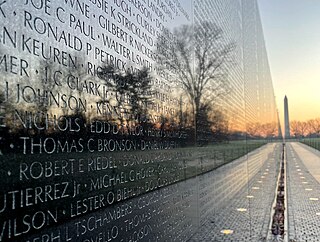
The Vietnam Veterans Memorial, commonly called the Vietnam Memorial, is a U.S. national memorial in Washington, D.C., honoring service members of the U.S. armed forces who served in the Vietnam War. The two-acre (8,100 m2) site is dominated by two black granite walls engraved with the names of those service members who died or remain missing as a result of their service in Vietnam and South East Asia during the war. The Memorial Wall was designed by American architect Maya Lin and is an example of minimalist architecture. The Wall, completed in 1982, has since been supplemented with the statue Three Soldiers in 1984 and the Vietnam Women's Memorial in 1993.
9. Jefferson Memorial
The Jefferson Memorial is a national memorial in Washington, D.C., built in honor of Thomas Jefferson, the principal author of the United States Declaration of Independence, a central intellectual force behind the American Revolution, a founder of the Democratic-Republican Party, and the nation's third president.
10. World War II Memorial
The World War II Memorial is a national memorial in the United States dedicated to Americans who served in the armed forces and as civilians during World War II. It is located on the National Mall in Washington, D.C.
11. Martin Luther King, Jr. Memorial
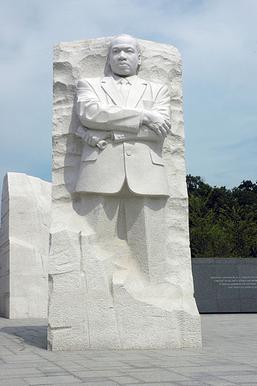
The Martin Luther King, Jr. Memorial is a national memorial located in West Potomac Park next to the National Mall in Washington, D.C., United States. It covers four acres (1.6 ha) and includes the Stone of Hope, a granite statue of civil rights movement leader Martin Luther King Jr. carved by sculptor Lei Yixin. The inspiration for the memorial design is a line from King's "I Have a Dream" speech: "Out of the mountain of despair, a stone of hope." The memorial opened to the public on August 22, 2011, after more than two decades of planning, fundraising, and construction.
12. Elbridge Gerry
Elbridge Gerry was an American Founding Father, merchant, politician, and diplomat who served as the fifth vice president of the United States under President James Madison from 1813 until his death in 1814. He is known to be the father and namesake of the political practice of gerrymandering.
13. Tom Lantos
Thomas Peter Lantos was a Hungarian- American politician who served as a U.S. representative from California from 1981 until his death in 2008. A member of the Democratic Party, he represented the state's 11th congressional district until 1993. After redistricting, he served from the 12th congressional district, which included both the northern two-thirds of San Mateo County and a portion of the southwestern part of San Francisco.
14. Ford's Theatre National Historic Site
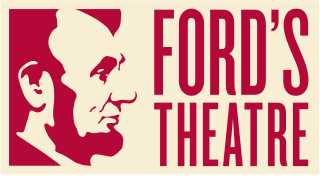
Ford's Theatre is a theater located in Washington, D.C., which opened in 1863. The theater is best known for being the site of the assassination of Abraham Lincoln. On the night of April 14, 1865, John Wilkes Booth entered the theater box where Lincoln was watching a performance of Tom Taylor's play Our American Cousin, slipped the single-shot, 5.87-inch derringer from his pocket and fired at Lincoln's head. After being shot, the fatally wounded Lincoln was carried across the street to the nearby Petersen House, where he died the next morning.
15. Korean War Veterans Memorial
The Korean War Veterans Memorial is located in Washington, D.C.'s West Potomac Park, southeast of the Lincoln Memorial and just south of the Reflecting Pool on the National Mall. It memorializes those who served in the Korean War (1950–1953). The national memorial was dedicated in 1995. It includes 19 statues representing U.S. military personnel in action. In 2022, the memorial was expanded to include a granite memorial wall, engraved with the names of U.S. military personnel who died in the war.
16. National Gallery of Art
The National Gallery of Art is an art museum in Washington, D.C., United States, located on the National Mall, between 3rd and 9th Streets, at Constitution Avenue NW. Open to the public and free of charge, the museum was privately established in 1937 for the American people by a joint resolution of the United States Congress. Andrew W. Mellon donated a substantial art collection and funds for construction. The core collection includes major works of art donated by Paul Mellon, Ailsa Mellon Bruce, Lessing J. Rosenwald, Samuel Henry Kress, Rush Harrison Kress, Peter Arrell Browne Widener, Joseph E. Widener, and Chester Dale. The Gallery's collection of paintings, drawings, prints, photographs, sculpture, medals, and decorative arts traces the development of Western art from the Middle Ages to the present, including the only painting by Leonardo da Vinci in the Americas and the largest mobile created by Alexander Calder.
17. National Museum of Natural History
The National Museum of Natural History (NMNH) is a natural history museum administered by the Smithsonian Institution, located on the National Mall in Washington, D.C., United States. It has free admission and is open 364 days a year. With 4.4 million visitors in 2023, it was the third most-visited museum in the United States.
Wikipedia: National Museum of Natural History (EN), Website, Facebook
18. Dupont Circle
Dupont Circle is a historic roundabout park and neighborhood of Washington, D.C., located in Northwest D.C. The Dupont Circle neighborhood is bounded approximately by 16th Street NW to the east, 22nd Street NW to the west, M Street NW to the south, and Florida Avenue NW to the north. Much of the neighborhood is listed on the National Register of Historic Places. However, the local government Advisory Neighborhood Commission and the Dupont Circle Historic District have slightly different boundaries.
19. Franklin Delano Roosevelt Memorial
The Franklin Delano Roosevelt Memorial is a presidential memorial in Washington D.C., dedicated to the memory of Franklin Delano Roosevelt, the 32nd president of the United States, and to the era he represents. The memorial is one of two in Washington honoring Roosevelt.
20. National Museum of American History
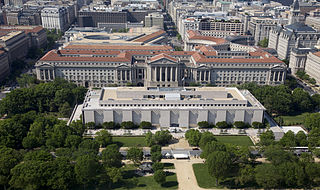
The National Museum of American History: Kenneth E. Behring Center is a historical museum in Washington, D.C. It collects, preserves, and displays the heritage of the United States in the areas of social, political, cultural, scientific, and military history. Among the items on display is the original Star-Spangled Banner. The museum is part of the Smithsonian Institution and located on the National Mall at 14th Street and Constitution Avenue NW in Washington, D.C.
Wikipedia: National Museum of American History (EN), Website
21. National Museum of the American Indian
The National Museum of the American Indian is a museum in the United States devoted to the culture of the Indigenous peoples of the Americas. It is part of the Smithsonian Institution group of museums and research centers.
Wikipedia: National Museum of the American Indian (EN), Website, Facebook, Instagram
22. National Museum of African American History and Culture
The National Museum of African American History and Culture (NMAAHC), colloquially known as the Blacksonian, is a Smithsonian Institution museum located on the National Mall in Washington, D.C., in the United States. It was established in 2003 and opened its permanent home in 2016 with a ceremony led by President Barack Obama.
Wikipedia: National Museum of African American History and Culture (EN), Website
23. Capitol Hill
Capitol Hill is a neighborhood in Washington, D.C., located in both Northeast D.C. and Southeast D.C.. Bounded by 14th Street SE & NE, F Street NE, Southeast Boulevard SE, South Capitol Street SE. Dominated by the United States Capitol, which sits on the highest point of Capitol Hill, it is one of the oldest historic districts in Washington. Home to around 35,000 people in just under 2 square miles (5 km2), Capitol Hill is also one of the most densely populated neighborhoods. The name "Capitol Hill" is frequently used as a metonym for the U.S. Congress.
24. Congressional Cemetery
The Congressional Cemetery, officially Washington Parish Burial Ground, is a historic and active cemetery located at 1801 E Street, S.E., in Washington, D.C., on the west bank of the Anacostia River. It is the only American "cemetery of national memory" founded before the Civil War. Over 65,000 individuals are buried or memorialized at the cemetery, including many who helped form the nation and Washington, D.C., in the early 19th century.
25. Statue of Freedom
The Statue of Freedom, also known as Armed Freedom or simply Freedom, is a bronze statue designed by Thomas Crawford that, since 1863, has crowned the United States Capitol dome. Originally named Freedom Triumphant in War and Peace, a U.S. government publication now states that the statue "is officially known as the Statue of Freedom." The statue depicts a female figure bearing a military helmet and holding a sheathed sword in her right hand and a laurel wreath and shield in her left.
26. Museum of the Bible
The Museum of the Bible is a museum in Washington, D.C., owned by Museum of the Bible, Inc., a non-profit organization established in 2010 by the Green family. The museum documents the narrative, history, and impact of the Bible. It opened on November 17, 2017, and has 1,150 items in its permanent collection and 2,000 items on loan from other institutions and collections.
27. Hirshhorn Sculpture Garden
The Hirshhorn Museum and Sculpture Garden is an art museum beside the National Mall in Washington, D.C., United States. The museum was initially endowed during the 1960s with the permanent art collection of Joseph H. Hirshhorn. It was designed by architect Gordon Bunshaft and is part of the Smithsonian Institution. It was conceived as the United States' museum of contemporary and modern art and currently focuses its collection-building and exhibition-planning mainly on the post–World War II period, with particular emphasis on art made during the last 50 years.
28. Leonard Matlovich

Technical Sergeant Leonard Phillip Matlovich was an American Vietnam War veteran, race relations instructor, and recipient of the Purple Heart and the Bronze Star. He was the first gay service member to purposely out himself to the military to fight their ban on gays, and perhaps the best-known openly gay man in the United States of America in the 1970s next to Harvey Milk. His fight to stay in the United States Air Force after coming out of the closet became a cause célèbre around which the gay community rallied. His case resulted in articles in newspapers and magazines throughout the country, numerous television interviews, and a television movie on NBC. His photograph appeared on the cover of the September 8, 1975, issue of Time magazine, making him a symbol for thousands of gay and lesbian servicemembers and gay people generally. Matlovich was the first named openly gay person to appear on the cover of a U.S. newsmagazine. According to author Randy Shilts, "It marked the first time the young gay movement had made the cover of a major newsweekly. To a movement still struggling for legitimacy, the event was a major turning point."
29. International Spy Museum
The International Spy Museum is an independent non-profit history museum which documents the tradecraft, history, and contemporary role of espionage. It holds the largest collection of international espionage artifacts on public display. The museum opened in 2002 in the Penn Quarter neighborhood of Washington, D.C., and relocated to L'Enfant Plaza in 2019.
30. Rose Garden
The White House Rose Garden is a garden bordering the Oval Office and the West Wing of the White House in Washington, D.C., United States. The garden is approximately 125 feet long and 60 feet wide. It balances the Jacqueline Kennedy Garden on the east side of the White House Complex. It is commonly used as a stage for receptions and media events due to its proximity to the White House.
31. Dumbarton Oaks
Dumbarton Oaks, formally the Dumbarton Oaks Research Library and Collection, is a historic estate in the Georgetown neighborhood of Washington, D.C. It was the residence and gardens of wealthy U.S. diplomat Robert Woods Bliss and his wife Mildred Barnes Bliss. The estate was founded by the Bliss couple, who gave the home and gardens to Harvard University in 1940.
32. Homeless Jesus
Homeless Jesus, also known as Jesus the Homeless, is a bronze sculpture by Timothy Schmalz depicting Jesus as a homeless person, sleeping on a park bench. The original sculpture was installed in 2013 at Regis College, a theological college federated with the University of Toronto. Other copies of the statue were installed in several other locations beginning in 2014. As of 2017, over 50 copies were created and placed around the world.
33. Pushmataha
Pushmataha was one of the three regional chiefs of the major divisions of the Choctaw in the 19th century. Many historians considered him the "greatest of all Choctaw chiefs". Pushmataha was highly regarded among Native Americans, Europeans, and white Americans, for his skill and cunning in both war and diplomacy.
34. National Museum of African Art
The National Museum of African Art is the Smithsonian Institution's African art museum, located on the National Mall of the United States capital. Its collections include 9,000 works of traditional and contemporary African art from both Sub-Saharan and North Africa, 300,000 photographs, and 50,000 library volumes. It was the first institution dedicated to African art in the United States and remains the largest collection. The Washington Post called the museum a mainstay in the international art world and the main venue for contemporary African art in the United States.
35. The Phillips Collection
The Phillips Collection is an art museum founded by Duncan Phillips and Marjorie Acker Phillips in 1921 as the Phillips Memorial Gallery located in the Dupont Circle neighborhood of Washington, D.C. Phillips was the grandson of James H. Laughlin, a banker and co-founder of the Jones and Laughlin Steel Company.
36. William Thornton
William Thornton was an American physician, inventor, painter and architect who designed the United States Capitol. He also served as the first Architect of the Capitol and first Superintendent of the United States Patent Office.
37. Theodore Roosevelt Island
Theodore Roosevelt Island is an 88.5-acre (358,000 m2) island and national memorial located in the Potomac River in Washington, D.C. During the Civil War, it was used as a training camp for the United States Colored Troops. The island was given to the federal government by the Theodore Roosevelt Association in memory of the 26th president, Theodore Roosevelt. Until then, the island had been known as My Lord's Island, Barbadoes Island, Mason's Island, Analostan Island, and Anacostine Island.
38. Arlington Memorial Bridge
The Arlington Memorial Bridge, often shortened to Memorial Bridge, is a Neoclassical masonry, steel, and stone arch bridge with a central bascule that crosses the Potomac River in Washington, D.C., the capital of the United States. First proposed in 1886, the bridge went unbuilt for decades thanks to political quarrels over whether the bridge should be a memorial, and to whom or what. Traffic problems associated with the dedication of the Tomb of the Unknown Soldier in November 1921 and the desire to build a bridge in time for the bicentennial of the birth of George Washington led to its construction in 1932.
39. Jefferson Pier Stone
Jefferson Pier, Jefferson Stone, or the Jefferson Pier Stone, in Washington, D.C., marks the second prime meridian of the United States even though it was never officially recognized, either by presidential proclamation or by a resolution or act of Congress.
40. Octagon House
The Octagon House, also known as the Colonel John Tayloe III House, is a house located at 1799 New York Avenue, Northwest in the Foggy Bottom neighborhood of Washington, D.C. It was built in 1799 for John Tayloe III, the wealthiest planter in the country, at the behest of his new family member, George Washington. In September 1814, after British forces burnt the White House during the War of 1812, for six months the Octagon House served as the residence of United States president James Madison and first lady Dolley Madison. It is one of only five houses to serve as the presidential residence in the history of the United States of America, and one of only three, along with the White House and Blair House, that still stand.
41. Emancipation Hall
The United States Capitol Visitor Center (CVC) is a large underground addition to the United States Capitol complex which serves as a gathering point for up to 4,000 tourists and an expansion space for the U.S. Congress. It is located below the landscaped tree-shaded grounds of the East Front of the Capitol and its plaza, topped by a thick plastic / glass skylight on the surface, between the Capitol building and 1st Street East, towards the east. The complex contains 580,000 square feet (54,000 m2) of space below ground on three levels. The overall project's budget was $621 million dollars.
42. National War College
The National War College (NWC) of the United States is a school in the National Defense University. It is housed in Roosevelt Hall on Fort Lesley J. McNair, Washington, D.C., the third-oldest Army post still active.
43. Ulysses S. Grant Statue
The Ulysses S. Grant Memorial is a presidential memorial in Washington, D.C., honoring American Civil War general and 18th president of the United States, Ulysses S. Grant. It sits at the base of Capitol Hill, below the west front of the United States Capitol. Its central sculpture of Grant on horseback faces west, overlooking the Capitol Reflecting Pool and facing toward the Lincoln Memorial, which honors Grant's wartime president, Abraham Lincoln. Grant's statue is raised on a pedestal decorated with bronze reliefs of the infantry; flanking pedestals hold statues of protective lions and bronze representations of the Union cavalry and artillery. The whole is connected with marble covered platforms, balustrades, and stairs. The Grant and Lincoln memorials define the eastern and western ends, respectively, of the National Mall.
44. George Mason Memorial
The George Mason Memorial is a memorial to Founding Father George Mason, the author of the Virginia Declaration of Rights that inspired the United States Bill of Rights. The Memorial is located in West Potomac Park within Washington, D.C. at 24 E Basin Drive SW, which is a part of the Tidal Basin. Authorized in 1990, with a groundbreaking in 2000 and dedication in 2002, the memorial includes a sculpture of Mason, a pool, trellis, circular hedges, and numerous inscriptions. It was the first memorial in the Tidal Basin area to be dedicated to someone who was not a former President of the United States.
45. Renwick Gallery
The Renwick Gallery is a branch of the Smithsonian American Art Museum located in Washington, D.C. that displays American craft and decorative arts from the 19th to 21st century. The gallery is housed in a National Historic Landmark building that was opened in 1859 on Pennsylvania Avenue and originally housed the Corcoran Gallery of Art. When it was built in 1859, it was called "the American Louvre", and is now named for its architect James Renwick Jr.
46. Vietnam Women's Memorial
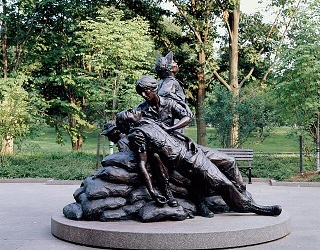
The Vietnam Women's Memorial is a memorial dedicated to the nurses and women of the United States who served in the Vietnam War. It depicts three uniformed women with a wounded male soldier to symbolize the support and caregiving roles that women played in the war as nurses and other specialists. It is part of the Vietnam Veterans Memorial and is located on the National Mall in Washington, D.C., a short distance south of the Wall and north of the Reflecting Pool. The statues are bronze and the base is made of granite. The United States Commission of Fine Arts and the National Capital Planning Commission selected Glenna Goodacre to sculpt the memorial after previously rejecting the idea for a memorial to women.
47. Japanese American Memorial
The Japanese American Memorial to Patriotism During World War II is a National Park Service site to commemorate the contributions of American citizens of Japanese ancestry and their parents who patriotically supported the United States despite unjust treatment during World War II.
Wikipedia: Japanese American Memorial to Patriotism During World War II (EN)
48. B Reactor Building
The B Reactor at the Hanford Site, near Richland, Washington, was the first large-scale nuclear reactor ever built. The project was a key part of the Manhattan Project, the United States nuclear weapons development program during World War II. Its purpose was to convert natural uranium metal into plutonium-239 by neutron activation, as plutonium is simpler to chemically separate from spent fuel assemblies, for use in nuclear weapons, than it is to isotopically enrich uranium into weapon-grade material. The B reactor was fueled with metallic natural uranium, graphite moderated, and water-cooled. It has been designated a U.S. National Historic Landmark since August 19, 2008 and in July 2011 the National Park Service recommended that the B Reactor be included in the Manhattan Project National Historical Park commemorating the Manhattan Project. Visitors can take a tour of the reactor by advance reservation.
49. Arthur M. Sackler Gallery
The Arthur M. Sackler Gallery is an art museum of the Smithsonian Institution in Washington, D.C., focusing on Asian art. The Sackler Gallery and the Freer Gallery of Art together form the National Museum of Asian Art in the United States. The Freer and Sackler galleries house the largest Asian art research library in the country.
50. White House Kitchen Garden
The White House has had multiple vegetable gardens since its completion in 1800. John and Abigail Adams, Eleanor Roosevelt, Hillary Clinton and Michelle Obama all have had their own versions of vegetable gardens. Roosevelt planted the White House victory garden during World War II to promote the use of victory gardens by American citizens in a time of possible food scarcity. Hillary Clinton had a vegetable garden constructed on the roof of the White House. On March 20, 2009, Michelle Obama broke ground on the largest and most expansive vegetable garden to date on the White House lawn.
51. DAR Constitution Hall
DAR Constitution Hall is a concert hall located at 1776 D Street NW, near the White House in Washington, D.C. It was built in 1929 by the Daughters of the American Revolution to house its annual convention when membership delegations outgrew Memorial Continental Hall. Later, the two buildings were connected by a third structure housing the DAR Museum, administrative offices, and genealogical library. DAR Constitution Hall is still owned and operated by the National Society of Daughters of the American Revolution. It was designated a National Historic Landmark in 1985. It has been a major cultural center of the city since its construction, and houses its largest auditorium.
52. James Jackson
James Jackson was an early British-born Georgia politician of the Democratic-Republican Party. He was a member of the U.S. House of Representatives from 1789 until 1791. He was also a U.S. Senator from Georgia from 1793 to 1795, and from 1801 until his death in 1806. In 1797 he was elected 23rd Governor of Georgia, serving from 1798 to 1801 before returning to the senate.
53. National Law Enforcement Officers Memorial
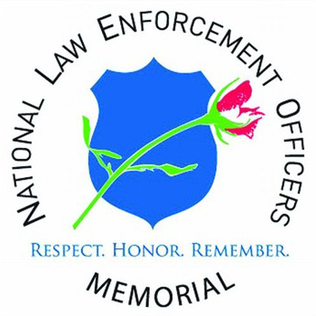
The National Law Enforcement Officers Memorial is in Washington, D.C., at Judiciary Square, adjacent to the National Law Enforcement Museum. It honors 23,785 U.S. law enforcement officers who have died in the line of duty throughout American history. The National Law Enforcement Officers Memorial Fund (NLEOMF) was established by former US Representative Mario Biaggi (D-NY), a 23-year New York City police veteran.
Wikipedia: National Law Enforcement Officers Memorial (EN), Website
54. Joseph Nicollet
Joseph Nicolas Nicollet, also known as Jean-Nicolas Nicollet, was a French geographer, astronomer, and mathematician known for mapping the Upper Mississippi River basin during the 1830s. Nicollet led three expeditions in the region between the Mississippi and Missouri Rivers, primarily in Minnesota, South Dakota, and North Dakota.
55. National World War I Memorial
The National World War I Memorial is a national memorial commemorating the service rendered by members of the United States Armed Forces in World War I. The 2015 National Defense Authorization Act authorized the World War I Centennial Commission to build the memorial in Pershing Park, located at 14th Street and Pennsylvania Avenue NW in Washington, D.C. The park, which has existed since 1981, also contains the John J. Pershing General of the Armies commemorative work. In January 2016, the design commission selected the submission "The Weight of Sacrifice", by a team consisting of Joseph Weishaar, Sabin Howard, Phoebe Lickwar, and GWWO Architects, as the winning design, which was completed in September 2024.
Wikipedia: National World War I Memorial (Washington, D.C.) (EN), Website
56. Andrew Jackson
Andrew Jackson is a bronze equestrian statue by Clark Mills mounted on a white marble base in the center of Lafayette Square within President's Park in Washington, D.C., just to the north of the White House. Jackson is depicted dressed in military uniform, raising his hat with his right hand, while controlling the reins with his left hand as his horse rises on its rear legs.
Wikipedia: Equestrian statue of Andrew Jackson (Washington, D.C.) (EN)
57. Joseph Gilbert Totten
Joseph Gilbert Totten fought in the War of 1812, served as Chief of Engineers and was regent of the Smithsonian Institution and cofounder of the National Academy of Sciences. In 1836, he was elected a member of the American Philosophical Society.
58. Archibald Henderson
Archibald Henderson was the longest-serving Commandant of the Marine Corps, serving from 1820 to 1859. His name is learned by all recruits at Marine recruit training as the "Grand old man of the Marine Corps," serving in the United States Marine Corps for over 52 years.
59. Monument to Balzac
Monument to Balzac is a sculpture by Auguste Rodin in memory of the French novelist Honoré de Balzac. According to Rodin, the sculpture aims to portray the writer's persona rather than a physical likeness. The work was commissioned in 1891 by the Société des Gens de Lettres and a full-size plaster model was displayed in 1898 at a Salon in Champ de Mars. After coming under criticism the model was rejected by the société and Rodin moved it to his home in Meudon. On 2 July 1939 the model was cast in bronze for the first time and placed on the Boulevard du Montparnasse at the intersection with Boulevard Raspail.
60. President Lincoln's Cottage
President Lincoln's Cottage is a historic home used by Abraham Lincoln on the grounds of the Soldiers' Home, known today as the Armed Forces Retirement Home, near the Petworth neighborhood in Washington, D.C. In 2000 it was designated a national monument called President Lincoln and Soldiers' Home National Monument.
Wikipedia: President Lincoln's Cottage at the Soldiers' Home (EN), Website
61. United States National Arboretum
The United States National Arboretum is an arboretum in northeast Washington, D.C., operated by the United States Department of Agriculture's Agricultural Research Service. It was established in 1927 by an act of Congress after a campaign by USDA Chief Botanist Frederick Vernon Coville.
62. Theodorick Bland
Theodorick Bland, also known as Theodorick Bland, Jr., was an American planter, physician, soldier, and politician from Prince George County, Virginia. A major figure in the formation of the new United States government, Bland represented Virginia in both the Continental Congress and the United States House of Representatives, as well as served multiple terms in the Virginia House of Delegates representing Prince George County, which he also represented in the Virginia Ratification Convention.
63. Zero Milestone
The Zero Milestone is a zero mile marker monument in Washington, D.C., intended as the initial milestone from which all road distances in the United States should be measured when it was built. At present, only roads in the Washington, D.C., area have distances measured from it.
64. DC War Memorial
The District of Columbia War Memorial commemorates the more than 26,000 "residents and citizens" of the District of Columbia who performed military service in World War I, including the 499 who gave their lives in that service. Located on the National Mall, it was constructed in 1931 as a domed, peristyle Doric temple designed to serve as a bandstand for public events. In a practice unusual for the time, the names are listed in alphabetical order, without regard to rank, gender, race, or national origin.
65. Old Greyhound Bus Terminal
The Old Greyhound Terminal was a bus terminal serving Greyhound Lines located at 1100 New York Avenue NW in Northwest, Washington, D.C. in the United States operating from 1940 to the 1980s. It was used extensively during World War II to transport servicemen, and played a minor role in the Civil Rights Movement. It was saved through the intervention of preservationists. Most of the building was incorporated in the new 1100 New York Avenue high-rise office building when it was built in 1991.
66. The Inn at Little Washington
The Inn at Little Washington is a luxury country inn and restaurant located in Washington, Virginia. Patrick O'Connell and Reinhardt Lynch founded the Inn in a former garage in 1978. It has been a member of the Relais & Châteaux hotel group since 1987, and is the only restaurant listed in the Michelin Guide for Washington, D.C. that is not located within the city limits. It is also the only three-star Michelin restaurant in the Washington, D.C., guide.
67. Taras Shevchenko Statue
The Taras Shevchenko Memorial is a bronze statue and stone relief-adorned wall located on the 2200 block of P Street NW in the Dupont Circle neighborhood of Washington, D.C., United States. It is one of many monuments in Washington, D.C. that honor foreign heroes who symbolize freedom in their native countries. Sculpted by Leo Mol, the memorial honors Taras Shevchenko (1814–1861), a Ukrainian poet and artist who influenced the development of modern Ukrainian literature.
68. The Ellipse
The Ellipse, sometimes referred to as President's Park South, is a 52-acre (21 ha) park south of the White House fence and north of Constitution Avenue and the National Mall in Washington, D.C., US. The Ellipse is also the name of the five-furlong (1.0 km) circumference street within the park. The entire park, which features monuments, is open to the public and is part of President's Park. The Ellipse is the location for many annual events.
69. Peace Monument
The Peace Monument, also known as the Navy Monument, Naval Monument or Navy-Peace Monument, stands on the western edge of the United States Capitol Complex in Washington, D.C. It is in the middle of Peace Circle, where First Street and Pennsylvania Avenue NW intersect. The surrounding area is Union Square, which the monument shares with the Ulysses S. Grant Memorial, James A. Garfield Monument, and the Capitol Reflecting Pool. The front of the monument faces west towards the National Mall while the east side faces the United States Capitol.
70. Toutorsky Mansion
The Toutorsky Mansion, also called the Brown-Toutorsky House, is a five-story, 18-room house located at 1720 16th Street, NW in the Dupont Circle neighborhood of Washington, D.C. Since 2012, it has housed the Embassy of the Republic of the Congo.
71. James A. Garfield Monument
The James A. Garfield Monument stands on the grounds of the United States Capitol in Garfield Circle, a traffic circle at First Street and Maryland Avenue SW in Washington, D.C. It is a memorial to U.S. President James A. Garfield, who was elected in 1880 and assassinated in 1881 after serving only four months of his term. The perpetrator was an attorney and disgruntled office-seeker named Charles J. Guiteau. Garfield lived for several weeks after the shooting, but eventually succumbed to his injuries. The monument is part of a three-part sculptural group near the Capitol Reflecting Pool, including the Peace Monument and the Ulysses S. Grant Memorial in Union Square. The monument is also a contributing property to the National Mall and L'Enfant Plan, both of which are listed on the National Register of Historic Places and the District of Columbia Inventory of Historic Sites. The bronze statue rests on a granite pedestal that features three sculptures, each one representing a time period in Garfield's life.
72. Major General Lafayette
Major General Marquis Gilbert de Lafayette is a statue in the southeast corner of Lafayette Square, in Washington, D.C., near the intersection of Pennsylvania Avenue and Madison Place, across the street from the White House. The statue was erected in 1891 to honor Gilbert du Motier, Marquis de Lafayette, and his contributions in the American Revolutionary War. The square, originally part of the President's Park, was named in honor of the Marquis in 1824 during a visit he made to the U.S. The statuary was made by Alexandre Falguière and Antonin Mercié, and the architect who designed the marble pedestal was Paul Pujol. The monument comprises a bronze statue of the Marquis de Lafayette about 11 ft (3.4 m) high, standing on a French marble pedestal with four faces decorated with classical mouldings, accompanied by seven additional bronze statues, all larger than life size.
Wikipedia: Statue of the Marquis de Lafayette (Washington, D.C.) (EN)
73. John Gould Stephenson
John Gould Stephenson was an American physician and soldier who served as Librarian of Congress from 1861 to 1864. Born in Lancaster, New Hampshire, to a prominent merchant family, he attended the Dartmouth Medical College and Castleton Medical College, where he received his M.D in 1849. Stephenson moved to Terre Haute, Indiana, in the early 1850s, where he became active in the temperance movement and the nascent Republican Party. He campaigned for Abraham Lincoln in the 1859 Senate race in Illinois and the 1860 presidential election. He pursued an appointment of Librarian of Congress immediately following Lincoln's election, possibly due to his brother's work as a librarian in Cincinnati. After a lengthy pressure campaign from prominent Republicans, Lincoln appointed Stephenson as Librarian of Congress, replacing long-term incumbent John Silva Meehan despite opposition from the Joint Committee on the Library.
74. Adams Memorial
The Adams Memorial is a grave marker for Marian Hooper Adams and Henry Adams located in Section E of Rock Creek Cemetery, Washington, D.C. The memorial features a cast bronze allegorical sculpture by Augustus Saint-Gaudens. Saint-Gaudens' shrouded-figure statue is seated against a granite block which takes up one side of a hexagonal plaza, designed by architect Stanford White. Across from the statue is a stone bench for visitors. The whole is sheltered by a close screen of dense conifers.
75. Decatur House
Decatur House is a historic house museum at 748 Jackson Place in Washington, D.C., the capital of the United States. It is named after its first owner and occupant, the naval officer Stephen Decatur Jr. Built in 1818, the house is located at the northwest corner of Lafayette Square, about a block from the White House.
76. Lincoln Park
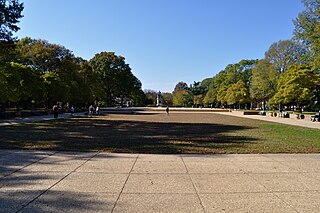
Lincoln Park is the largest urban park located in the Capitol Hill neighborhood of Washington, D.C. It was known historically as Lincoln Square. From 1862 to 1865, it was the site of the largest hospital in Washington, DC: Lincoln Hospital.
77. General William T. Sherman Monument
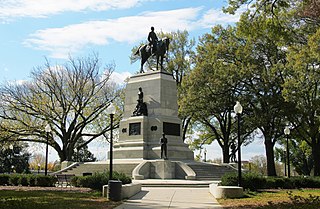
The General William Tecumseh Sherman Monument is an equestrian statue of American Civil War Major General William Tecumseh Sherman located in Sherman Plaza, which is part of President's Park in Washington, D.C., in the United States. The selection of an artist in 1896 to design the monument was highly controversial. During the monument's design phase, artist Carl Rohl-Smith died, and his memorial was finished by a number of other sculptors. The Sherman statue was unveiled in 1903. It is a contributing property to the Civil War Monuments in Washington, D.C. and to the President's Park South, both of which are historic sites listed on the National Register of Historic Places.
Wikipedia: General William Tecumseh Sherman Monument (EN), Heritage Website
78. National Museum Of American Jewish Military History
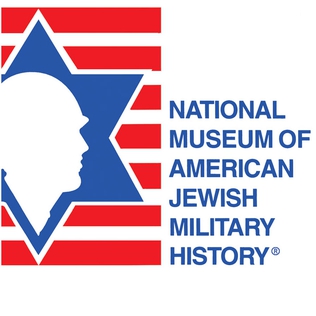
The National Museum of American Jewish Military History (NMAJMH) was founded September 2, 1958, in Washington, D.C., to document and preserve "the contributions of Jewish Americans to the peace and freedom of the United States...[and to educate] the public concerning the courage, heroism and sacrifices made by Jewish Americans who served in the armed forces." It operates under the auspices of the Jewish War Veterans of the United States of America (JWV), National Memorial, Inc. (NMI), and is located at 1811 R Street NW, Washington, D.C., in the Dupont Circle area, in the same building that houses the JWV National Headquarters.
Wikipedia: National Museum of American Jewish Military History (EN), Website
79. Franklin Square
Franklin Square, or Franklin Park, is a square in downtown Washington, D.C. Purportedly named after Benjamin Franklin, it is bounded by K Street NW to the north, 13th Street NW on the east, I Street NW on the south, and 14th Street NW on the west. It is served by the McPherson Square station of the Washington Metro, which is located just southwest of the park.
80. Capital Jewish museum
The Capital Jewish Museum, officially the Lillian & Albert Small Capital Jewish Museum, is a historical society and museum in Washington, D.C., focused on the history of Jewish life in the American capital city and the surrounding Washington metropolitan area.
Wikipedia: Lillian & Albert Small Capital Jewish Museum (EN)
81. Pennsylvania Trolley Museum
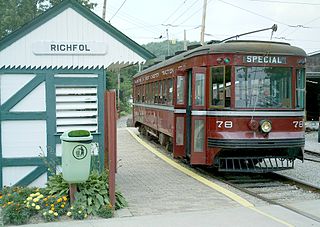
The Pennsylvania Trolley Museum is a museum in Washington, Pennsylvania, dedicated to the operation and preservation of streetcars and trolleys. The museum primarily contains historic trolleys from Pennsylvania, but its collection includes examples from nearby Toledo, New Orleans, and even an open-sided car from Brazil. Many have been painstakingly restored to operating condition. Other unique cars either awaiting restoration or that are incompatible with the 5' 2-1/2" Pennsylvania trolley gauge track are on display in a massive trolley display building. Notable examples of static display include a J.G. Brill “Brilliner” car, locomotives, and a horse car from the early days of Pittsburgh’s public transit systems.
82. Sheridan Circle
Sheridan Circle is a traffic circle and park in the Sheridan-Kalorama neighborhood of Washington, D.C. The traffic circle, one of two in the neighborhood, is the intersection of 23rd Street NW, Massachusetts Avenue NW, and R Street NW. The buildings along this stretch of Massachusetts Avenue NW are part of Embassy Row, which runs from Scott Circle to Observatory Circle. Sheridan Circle is a contributing property to the Massachusetts Avenue Historic District and the Sheridan-Kalorama Historic District, both listed on the National Register of Historic Places (NRHP). In addition, the equestrian statue of General Philip Sheridan is 1 of 18 Civil War Monuments in Washington, D.C., that were collectively listed on the NRHP.
83. McPherson Square
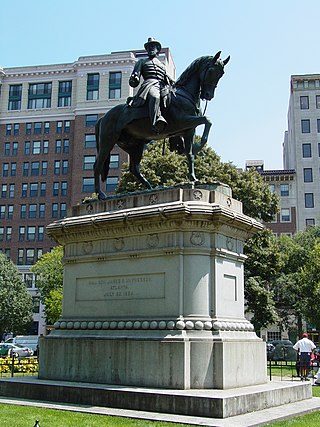
McPherson Square is a public square in downtown Washington, D.C. It is bound by K Street Northwest to the north, Vermont Avenue NW on the East, I Street NW on the south, and 15th Street NW on the West; it is one block northeast of Lafayette Park. It is the sister square of Farragut Square two blocks west. It is served by the McPherson Square station of the Washington Metro.
84. Admiral David G Farragut
Admiral David G. Farragut is a statue in Washington, D.C., honoring David Farragut, a career military officer who served as the first admiral in the United States Navy. The monument is sited in the center of Farragut Square, a city square in downtown Washington, D.C. The statue was sculpted by female artist Vinnie Ream, whose best-known works include a statue of Abraham Lincoln and several statues in the National Statuary Hall Collection. The monument was dedicated in 1881 in an extravagant ceremony attended by President James A. Garfield, members of his cabinet, and thousands of spectators. It was the first monument erected in Washington, D.C., in honor of a naval war hero.
85. George Gordon Meade Memorial
The George Gordon Meade Memorial, also known as the Meade Memorial or Major General George Gordon Meade, is a public artwork in Washington, D.C. honoring George Meade, a career military officer from Pennsylvania who is best known for defeating General Robert E. Lee at the Battle of Gettysburg. The monument is sited on the 300 block of Pennsylvania Avenue NW in front of the E. Barrett Prettyman United States Courthouse. It was originally located at Union Square, but was removed and placed in storage for fourteen years before being installed at its current location. The statue was sculpted by Charles Grafly, an educator and founder of the National Sculpture Society, and was a gift from the state of Pennsylvania. Prominent attendees at the dedication ceremony in 1927 included President Calvin Coolidge, Governor John Stuchell Fisher, Secretary of the Treasury Andrew W. Mellon, and Senator Simeon D. Fess.
86. Hahnemann Monument
The Samuel Hahnemann Monument, also known as Dr. Samuel Hahnemann, is a public artwork dedicated to Samuel Hahnemann, the founder of homeopathy. It is located on the east side of Scott Circle, a traffic circle in the northwest quadrant of Washington, D.C. The Classical Revival monument consists of an exedra designed by architect Julius Harder and a statue sculpted by Charles Henry Niehaus, whose works include the John Paul Jones Memorial in Washington, D.C., and several statues in the National Statuary Hall Collection. The monument is significant because Hahnemann is the first foreigner not associated with the American Revolution to be honored with a sculpture in Washington, D.C.
87. Brigadier General Kosciuszko
Brigadier General Thaddeus Kościuszko is a bronze statue honoring Polish military figure and engineer Tadeusz Kościuszko. The sculpture was dedicated in 1910, the third of four statues in Lafayette Square, Washington, D.C., to honor foreign-born heroes of the American Revolutionary War. Born in the Polish–Lithuanian Commonwealth in 1746, Kościuszko later received education at a Jesuit school before attending the Corps of Cadets in Warsaw. He later traveled to France where he studied in military academy libraries and adopted views of human liberty during the Age of Enlightenment. He moved to the Thirteen Colonies in 1776, where the war with the Kingdom of Great Britain had already begun. Kościuszko served as an engineer in the Continental Army, earning the praise of his superiors, including General George Washington.
Wikipedia: Statue of Tadeusz Kościuszko (Washington, D.C.) (EN)
88. Laogai Museum
The Laogai Museum is a museum in Dupont Circle, Washington, D.C., United States, which showcases human rights in the People's Republic of China, focusing particularly on Láogǎi, the Chinese prison system of "Reform through Labor". The creation of the museum was spearheaded by Harry Wu, a well-known Chinese dissident who himself served 19 years in laogai prisons; it was supported by the Yahoo! Human Rights Fund. It opened to the public on 12 November 2008, and Wu's non-profit research organization calls it the first museum in the United States to directly address the issue of human rights in China. It is now permanently closed.
89. Beth Israel Congregation
Beth Israel Congregation is a Conservative synagogue located at 265 North Avenue in Washington, Pennsylvania, in the United States. Founded in 1891, it was the first Jewish congregation in Washington County. Its first rabbi, Jacob Goldfarb, served for 50 years.
Wikipedia: Beth Israel Congregation (Washington, Pennsylvania) (EN)
90. Thomas Tudor Tucker
Thomas Tudor Tucker was a Bermuda-born American physician and politician representing Charleston, South Carolina. He was elected from South Carolina in both the Continental Congress and the U.S. House. He later was appointed as Treasurer of the United States and served from 1801 to his death in 1828, establishing a record as the longest-serving Treasurer.
91. Thomas Circle
Thomas Circle is a traffic circle in Northwest Washington, D.C., United States. It is located at the intersection of 14th Street, M Street, Massachusetts Avenue, and Vermont Avenue NW. A portion of Massachusetts Avenue travels through a tunnel underneath the circle. The interior of the circle includes the equestrian statue of George Henry Thomas, a Union Army general in the Civil War.
92. Farragut Square
Farragut Square is a city square in Washington, D.C.'s Ward 2. It is bordered by K Street NW to the north, I Street NW to the south, on the east and west by segments of 17th Street NW, and interrupts Connecticut Avenue NW. It is the sister park of McPherson Square two blocks east. It is serviced by two stops on the Washington Metro rail system: Farragut North on the Red Line and Farragut West on the Blue, Orange, and Silver Lines.
93. Major General von Steuben
Major General Friedrich Wilhelm von Steuben is a bronze statue of Friedrich Wilhelm von Steuben, a Prussian soldier who assisted the Thirteen Colonies during the American Revolutionary War. Steuben had fought in previous wars, earning promotions until he assisted in the courts of Frederick the Great and later Josef Friedrich Wilhelm, Prince of Hohenzollern-Hechingen. After meeting with Benjamin Franklin, and fearing for his safety in Europe after alleged homosexual behavior, Steuben and his associates arrived to help the Continental Army.
94. Major General Rochambeau
Major General Comte Jean de Rochambeau is a bronze statue honoring Jean-Baptiste Donatien de Vimeur, comte de Rochambeau, a French nobleman and general who played a major role in helping the Thirteen Colonies win independence during the American Revolutionary War. Rochambeau joined the French military as a teenager, participating in the War of Austrian Succession, after which he was promoted to colonel, and the Seven Years' War. During the war in America, Louis XVI asked Rochambeau to lead a force of 5,500 French soldiers to assist the fight against the Kingdom of Great Britain. He and George Washington later worked together in the successful siege of Yorktown. He led the Army of the North during the French Revolutionary Wars, but was arrested and almost executed during the Reign of Terror. His military rank was restored by Napoleon and Rochambeau died a few years later in 1807.
95. Edmund Burke Statue
Edmund Burke is a bronze, full-length statue of British statesman, author, orator, political theorist, and philosopher Edmund Burke by British artist James Havard Thomas. The original statue is in Bristol, England, with a second cast in Washington, D.C. The statue in Washington, D.C., stands in Burke Park, at the intersection of 11th Street, L Street, and Massachusetts Avenue NW, on the southern border of the Shaw neighborhood. The statue was a gift from the Charles Wakefield, 1st Viscount Wakefield, on behalf of the Sulgrave Institution, an organization that wanted to celebrate United Kingdom–United States relations. One way the group did this was by exchanging statues and busts between the two countries.
96. John Paul Jones Memorial
The John Paul Jones Memorial, also known as Commodore John Paul Jones, is a monument in West Potomac Park, Washington, D.C. The memorial honors John Paul Jones, the United States' first naval war hero, and received the Congressional Gold Medal after the American Revolutionary War ended. Jones allegedly said "I have not yet begun to fight!" during the Battle of Flamborough Head.
97. National Gallery of Art Sculpture Garden
The National Gallery of Art Sculpture Garden is the most recent addition to the National Gallery of Art in Washington, D.C. in the United States. It is located in the National Mall between the National Gallery's West Building and the Smithsonian Institution's National Museum of Natural History.
98. Major General John A. Rawlins Statue
The statue of John Aaron Rawlins, a United States Army general who served during the Civil War and later as Secretary of War, is a focal point of Rawlins Park, a small public park in Washington, D.C.'s Foggy Bottom neighborhood. It was installed in 1874, but relocated several times between 1880 and 1931. The statue was sculpted by French-American artist Joseph A. Bailly, whose best known work is the statue of George Washington in front of Independence Hall in Philadelphia.
99. Nuns of the Battlefield Civil War Nurses Monument
Nuns of the Battlefield is a public artwork made in 1924 by Irish artist Jerome Connor, located at the intersection of Rhode Island Avenue NW, M Street, and Connecticut Avenue NW, in Washington, D.C., United States. A tribute to the more than 600 nuns who nursed soldiers of both the Union Army and the Confederate States Army during the American Civil War, it is one of two monuments in the District that mark women's roles in the conflict. It is a contributing monument to the Civil War Monuments in Washington, D.C., listed on the National Register of Historic Places. In 1993, it was surveyed for the Smithsonian Institution's Save Outdoor Sculpture! program.
100. Fort Bunker Hill Park
Fort Bunker Hill was one of seven temporary earthwork forts part of the Civil War Defenses of Washington, D.C., during the Civil War built in the Northeast quadrant of the city at the beginning of the Civil War by the Union Army to protect the city from the Confederate Army. From west to east, the forts were: Fort Slocum, Fort Totten, Fort Slemmer, Fort Bunker Hill, Fort Saratoga, Fort Thayer and Fort Lincoln. Unlike other forts, today very little remains of the structure.
Share
How likely are you to recommend us?
Disclaimer Please be aware of your surroundings and do not enter private property. We are not liable for any damages that occur during the tours.
